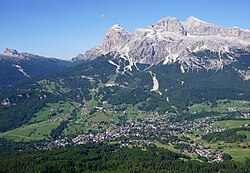| Falzarego Pass | |
|---|---|
 Lagazuoi cable car starts from Falzarego Pass | |
| Elevation | 2,105 m (6,906 ft) |
| Length | 15 km (9.3 mi) |
| Traversed by | SS48 |
| Location | Belluno, Italy |
| Range | Dolomites |
| Coordinates | 46°31′8″N12°0′34″E / 46.51889°N 12.00944°E |
The Falzarego Pass (Italian : Passo di Falzarego, Ladin : Jou de Fauzare) (el. 2,105 m) is a high mountain pass in the province of Belluno in Italy.
Contents
It mainly connects the territory of Agordo and Cortina d'Ampezzo. From the pass, starts also SP24 (Strada provinciale del Passo di Valparola) directed northbound to Val Badia passing below Sass de Stria and through Valparola Pass.
A gondola rises to the Lagazuoi (2,762 m), which was the object of heavy combat and mine warfare in World War I. The tunnel that the Italians built under the Austro-Hungarian lines is open to the public.


